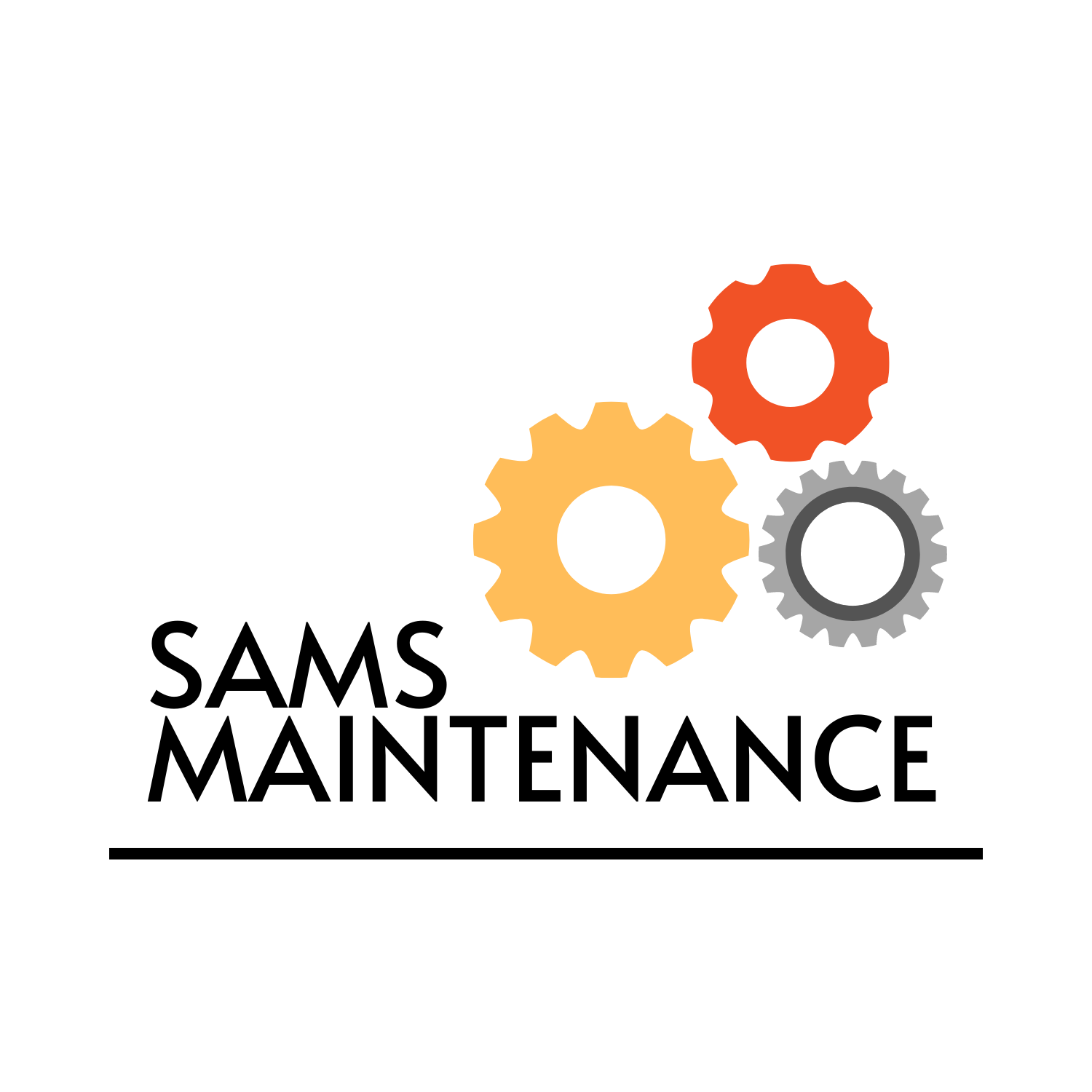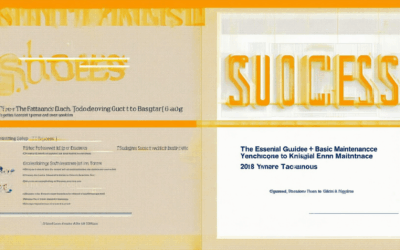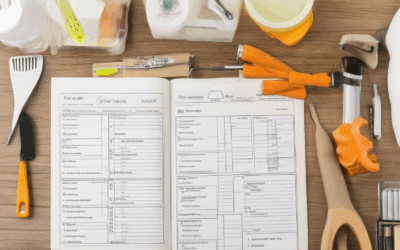Are you a homeowner looking to keep your house in top shape? Maintaining a home can feel overwhelming, especially when you’re juggling a busy schedule and trying to prevent minor issues from becoming major problems. Whether you’re new to homeownership or just looking to refine your routine, finding a reliable system for home maintenance is key to preserving your investment and ensuring your family’s safety. In this guide, we’ll walk you through creating a simple, effective schedule that covers everything from weekly chores to annual checks, helping you stay on top of your home’s care year-round. By following a consistent plan, you’ll not only save time but also protect your property’s value and enjoy the peace of mind that comes with a well-maintained home. From basic tasks to advanced strategies, this guide has you covered, offering practical advice and downloadable resources to make home maintenance easier than ever. Stay tuned to discover how you can keep your house in prime condition with a personalized maintenance schedule designed to fit your lifestyle.
Key Takeaways
– Exterior Maintenance: Regularly inspect and clean gutters, check for loose or damaged shingles, trim overhanging branches, inspect the foundation for cracks, and maintain chimney and flue.
– Interior Maintenance: Keep floors and surfaces clean, check for peeling paint or wallpaper, inspect carpets for wear, service hardwood floors, and monitor for mold or mildew.
– Appliance Maintenance: Schedule annual checks for furnaces, air conditioners, dryers, water heaters, and refrigerators to ensure proper functionality and energy efficiency.
– Plumbing Maintenance: Look for leaks, drain hoses before winter, inspect for mineral buildup, test water pressure, and replace outdated fixtures.
– HVAC Maintenance: Tune up systems annually, change air filters, inspect ductwork, test for carbon monoxide, and optimize thermostat settings.
– Electrical Safety: Inspect circuit breakers, check for exposed wires, replace outdated components, test GFCI outlets, and ensure smoke and CO detectors are functional.
– Landscape Maintenance: Maintain lawn health, clean gutters, inspect decks and fences, and address pest or disease issues in plants.
– Home Maintenance Strategy: Conduct annual inspections, follow monthly checklists, service major systems, budget 1-4% of home value annually, and stay proactive to avoid costly repairs.
– Resources: Visit Sam’s Maintenance for expert guidance, DIY guides, and maintenance plans.

Regular House Maintenance Checklist
We recommend the following monthly maintenance tasks to keep your home in great shape:
- Monthly Cleaning
- Clean bathrooms, including tiles, grout, and mirrors.
- Kitchen cleanup: wipe down countertops, inside sinks, and appliances.
- vacuum floors and dust furniture.
- Take out trash and recycling regularly.
- HVAC System Check
- Change or clean air filters monthly.
- Inspect vents for dirt or blockages.
- Schedule a professional tune-up if needed.
- Plumbing Inspections
- Check for leaky pipes under sinks and toilets.
- Run water through drains to detect clogs.
- Use a drain cleaner as needed.
- Electrical Systems
- Test ground fault circuit interrupters (GFCIs).
- Check circuit breakers and fuse boxes.
- Smoke detector and carbon monoxide detector checks.
- Roof and Chimney
- Inspect for missing or damaged shingles.
- Check chimney for cracks or damage.
- Hire a professional for annual inspections.
- Landscaping
- Trim trees and bushes monthly.
- Mow and edge lawn areas.
- Check for pests and weeds.
- Fire Safety
- Test smoke detectors monthly.
- Ensure fire extinguishers are functional and placed strategically.
- Check for proper functioning of carbon monoxide detectors.
- Window and Door Checks
- Look for cracks or peeling paint around windows and doors.
- Test door locks and window openers.
- Inspect weatherstripping for gaps.
- Attic and Basement Inspections
- Check for moisture or mold issues.
- Inspect for structural problems.
- Organize storage areas to prevent clutter.
- Water Heater and Pipes
- Flush the water heater monthly to prevent sediment buildup.
- Check pipes for signs of wear or corrosion.
- Insulate exposed pipes if necessary.
- Garbage Disposal
- Clean the disposal unit monthly.
- Prevent clogs by avoiding hard foods.
- Scheduled maintenance as recommended by the manufacturer.
- Foundation Checks
- Inspect foundation for cracks or unevenness.
- Check for signs of moisture or rot.
- Hire a professional for thorough inspections.
- Kitchen and Laundry Appliances
- Clean vent hood filters regularly.
- Check for proper function of appliances.
- Schedule routine maintenance for major appliances.
- Outdoor Lighting
- Test all outdoor lights and fixtures.
- Replace burned-out bulbs as needed.
- Inspect wiring for damage or wear.
- Seasonal Upkeep
- Prepare for extreme weather conditions.
- Adjust outdoor spaces for seasonal changes.
- Store outdoor furniture and tools properly.
- Pest Control
- Schedule regular pest control treatments.
- Seal entry points to prevent pests.
- Inspect for signs of infestation monthly.
- Security Systems
- Test alarm systems and motion sensors.
- Check video surveillance equipment.
- Schedule professional service visits.
- Fireplace and Pool Equipment
- Inspect chimney for cleanliness and damage.
- Check pool equipment for proper function.
- Flush pool filters and test water quality.
- HVAC Filters
- Replace or clean air filters as specified by the manufacturer.
- Check for airflow issues.
- Schedule filter replacement reminders.
- Sprinkler Systems
- Inspect sprinklers for leaks or damage.
- Check for proper watering coverage.
- Winterize the system before freezing temperatures.
Creating a Simple Home Maintenance Schedule
Maintaining your home requires consistent effort to ensure everything runs smoothly. Here’s a step-by-step guide to creating a simple yet effective home maintenance schedule:
Monthly Tasks
- Check HVAC System: Inspect filters, vents, and ductwork for cleanliness and blockages.
- Inspect Plumbing: Look for leaks near sinks, toilets, and pipes.
- Examine Roof: Check for missing shingles, cracks, or damage.
- Paint and Stain Check: Ensure exterior surfaces are in good condition.
- Prune Trees/Bushes: Trim overgrown plants to maintain health and visibility.
- Clean Gutters: Remove debris and check for proper alignment.
- Foundation Inspection: Look for cracks or signs of movement.
- Window/Door Check: Inspect frames for peeling paint and tightness.
- Appliance Check: Test stove, refrigerator, and water heater function.
- Smoke/CO Detectors: Ensure alarms are working and batteries are fresh.
- Electrical Systems: Check switches, outlets, and cords for damage.
- Garden/Yard Care: Mow, fertilize, and water lawn; trim grass and edges.
Quarterly Tasks
- Oven/Rangehood Clean: Wipe interior and exhaust fan.
- Washing Machine/Dryer Vent: Clean vent pipes and check for blockages.
- Chimney Inspection: Look for creosote buildup and structural issues.
- Garage Door Opener/Springs: Test operation and adjust if needed.
Seasonal Tasks
- Winter Prep: Clear gutters, move plants indoors, insulate pipes.
- Spring Cleaning: Pressure wash decks/patios, perform full house inspection.
- Summer Storm Prep: Secure outdoor furniture, check AC unit.
- Fall Prep: Rake leaves, clean gutters, check furnace.
Annual Tasks
- Replace Filters: Air, furnace, and humidifier filters.
- Roof Inspection: Check for damage and wear.
- Professional Inspections: Chimney, HVAC, and electrical systems.
- Update Electrical Panel/GFCI: Ensure safety features are current.
- Review Insurance Policy: Ensure adequate coverage.
By following this schedule, you’ll maintain your home’s health and longevity. Remember to consult professionals for tasks requiring specialized skills. Stay organized with a checklist and enjoy the benefits of a well-maintained home!

The 1% Rule for Home Maintenance
The 1% rule for home maintenance suggests setting aside 1% of your home’s appraised value annually to cover unexpected repair costs. This rule helps homeowners prepare financially for unforeseen issues, ensuring that minor problems don’t escalate into major, costly repairs.
For example, if your home is valued at $250,000, you would aim to save approximately $2,500 each year. This fund can be used for a variety of maintenance tasks, including fixing a leaky roof, replacing worn-out appliances, or addressing structural issues.
Why the 1% Rule?
The 1% rule is a common recommendation among real estate professionals and home maintenance experts. It reflects the average cost of maintaining a home over time. By saving 1%, you’re essentially preparing for 99% of potential maintenance issues, which are often unpredictable.
Considerations and Flexibility
This rule isn’t one-size-fits-all. Factors like the age of your home, its condition, and your location can influence how much you should save. For instance, older homes may require more frequent maintenance, while newer homes might need less. Additionally, living in an area prone to severe weather can increase maintenance needs.
Adjust the percentage based on your personal financial situation and the unique requirements of your home. Some experts recommend increasing the percentage if you live in a high-maintenance area or have a larger property with more systems to maintain.
How to Allocate Funds
Once you’ve determined your annual savings amount, decide how to allocate it. Emergencies like roof repairs or plumbing issues should take priority. After that, you can use the funds for routine tasks like lawn care, gutter cleaning, and checking appliances.
Regularly reviewing your home’s condition and updating your maintenance plan can help ensure you’re using your savings effectively. Consider working with a professional inspector to identify potential issues early.
Benefits of the 1% Rule
Following the 1% rule offers several advantages. It prevents financial stress caused by unexpected repairs and ensures that small issues don’t become major problems. Additionally, it can extend the lifespan of your home’s components, potentially saving money in the long run.
Downsides and Risks
While the 1% rule is a useful guideline, it’s important to be aware of its limitations. If you underestimate your home’s value or neglect necessary maintenance, you might find yourself spending more than intended. Regularly reassessing your home’s value and adjusting your savings accordingly can mitigate this risk.
Implementation Tips
To successfully implement the 1% rule, start by opening a dedicated savings account for home maintenance. Automate monthly contributions to make saving easier. Additionally, stay informed about potential maintenance needs through newsletters or updates from local real estate experts.
By following these steps, you can establish a robust home maintenance budget that protects your investment and ensures your home remains in great shape for years to come.

What Maintenance is Required for a House?
Maintaining a house requires consistent effort to ensure it remains in good condition and functions properly. Here’s a comprehensive guide to the essential maintenance tasks:
- Exterior Maintenance
- Inspect and clean gutters and downspouts regularly.
- Check for loose or damaged shingles and repair as needed.
- Trim trees and bushes to prevent branches from touching the roof or siding.
- Inspect the foundation for cracks or damage and seal them if necessary.
- Clean and inspect the chimney and flue for obstructions or damage.
- Interior Maintenance
- Dust and vacuum floors, walls, and furniture regularly.
- Check for peeling paint or wallpaper and repaint as needed.
- Inspect carpets for stains, holes, or wear and replace if necessary.
- Service hardwood floors by refinishing or replacing boards as needed.
- Check for mold or mildew in bathrooms, basements, and other damp areas.
- Appliance Maintenance
- Furnace/Heater Check: Inspect filters, ensure proper airflow, and test functionality.
- Air Conditioner Service: Clean coils, check refrigerant levels, and ensure proper cooling.
- Dryer Venting: Clean vent pipes and ensure they are free of lint buildup.
- Water Heater Inspection: Check for leaks, sediment buildup, and proper temperature regulation.
- Refrigerator Maintenance: Clean coils, organize shelves, and check door seals.
- Plumbing Maintenance
- Check for leaky pipes, faucets, or fixtures under sinks and around the toilet.
- Drain standing water from hoses and sprinklers before winter.
- Inspect and clean showerheads, bathtubs, and sinks for mineral buildup.
- Test water pressure and temperature for imbalances or unusual sounds.
- Replace worn-out washers, valves, or connectors as needed.
- HVAC System Maintenance
- Schedule regular tune-ups for your furnace, heat pump, or air conditioner.
- Change or clean air filters monthly to ensure efficient heating and cooling.
- Inspect ductwork for leaks, blockages, or rodents.
- Check for signs of carbon monoxide poisoning by testing CO levels.
- Ensure your thermostat is functioning correctly and set it appropriately for energy savings.
- Electrical System Maintenance
- Inspect circuit breakers and fuse boxes for damage or tripping issues.
- Check for exposed wires, loose connections, or flickering lights.
- Replace outdated or faulty switches, outlets, or wiring.
- Test GFCI (Ground Fault Circuit Interrupter) outlets to ensure they work properly.
- Inspect smoke detectors and carbon monoxide detectors for proper function and battery replacement.
- Landscape Maintenance
- Prune trees and shrubs to maintain shape and health.
- Edge and fertilize lawns as needed.
- Clean out flower beds, remove weeds, and prepare soil for planting season.
- Inspect for pests or diseases in plants and treat as necessary.
- Check for dead or diseased trees and remove them if needed.
Regular maintenance helps extend the life of your home, prevents costly repairs, and ensures a safe and comfortable living environment. Remember to address issues promptly and consult professionals if needed for specialized tasks.
Formula for Home Maintenance
To maintain your home effectively, consider the following comprehensive approach:
Key Components of Home Maintenance
- Annual Inspections
- Check for wear and tear in critical areas like roofs, chimneys, and HVAC systems.
- Schedule professional inspections for systems like plumbing and electrical wiring.
- Monthly Checklists
- Clear gutters and check for missing shingles.
- Test smoke detectors and carbon monoxide alarms.
- Examine grout and caulk in bathrooms and kitchens.
- Major Systems
- HVAC systems should be serviced annually or as recommended by the manufacturer.
- Replace water heaters every 10-12 years and inspect plumbing fixtures regularly.
- Roofing requires annual checks for leaks or damage.
Budgeting for Maintenance
- Percentage Rule : Aim to spend 1% to 4% of your home’s value annually on maintenance.
- Example: A $350,000 home should budget around $3,500 yearly.
Tips for Success
- Create a sinking fund for unexpected repairs.
- Regularly update finishes and fixtures to prevent aging.
- Avoid ignoring small issues, as they often lead to costly repairs.
Resources
For detailed guidance, visit Sams Maintenance for expert tips and tools. Explore our maintenance plans and DIY guides .
By following this structured approach, you can keep your home in excellent shape and save money long-term.

General Home Maintenance: A Comprehensive Guide
Home maintenance refers to the routine tasks necessary to keep a property in good condition. Regular upkeep ensures safety, comfort, and longevity for your living space. Here’s a detailed guide to managing various aspects of home maintenance effectively.
Overview of Home Maintenance
Effective home maintenance involves a combination of daily chores and annual checks. It helps prevent costly repairs and extends the lifespan of your property. Key areas include cleaning, repairs, inspections, and upgrades.
Cleaning and Sanitation
- Regular Cleaning: Vacuum carpets, mop floors, and wipe surfaces to maintain hygiene and reduce allergens.
- GFCI Outlets: Test Ground Fault Circuit Interrupters to ensure electrical systems are safe.
- Appliance Care: Clean laundry machines, dishwashers, and HVAC units to prevent blockages and extend appliance life.
Plumbing Systems
- Leak Detection: Check pipes and fixtures for drips or leaks, especially around sinks and toilets.
- Water Pressure: Test showerheads and faucets to ensure optimal water flow and adjust pressure as needed.
- Drain Maintenance: Use drain cleaners monthly to prevent clogs and ensure smooth water flow.
Heating, Ventilation, and Air Conditioning (HVAC)
- Filter Replacement: Change air filters every 1-3 months to maintain efficiency and indoor air quality.
- Servicing: Schedule professional HVAC tune-ups annually to ensure proper functioning and energy efficiency.
- Ductwork Inspections: Clean ducts and check for blockages to ensure airflow and prevent mold growth.
Landscaping and Exterior Maintenance
- Lawn Care: Mow grass, trim trees, and prune shrubs to maintain curb appeal and yard health.
- Gutter Cleaning: Remove debris from gutters to prevent water damage and roof deterioration.
- Deck and Fence Maintenance: Sand and repaint decks, and tighten loose fence panels to preserve structural integrity.
Electrical Systems
- Outlet Testing: Periodically check all outlets to ensure they are functioning correctly and safely.
- Switch Plate Checks: Verify that all switches and plates are securely attached and functioning as intended.
- Light Bulb Replacement: Replace bulbs as needed to ensure proper lighting and safety.
Roofing and Foundation
- Roof Inspection: Check for missing shingles, curled edges, and potential leaks to prevent interior damage.
- Foundation Cracks: Inspect foundation walls for cracks or shifts that could indicate structural issues.
- Gutter and Downspout Functionality: Ensure gutters and downspouts are clear to direct water away from your home.
Conclusion
Regular home maintenance is essential for preserving your property’s value and ensuring long-term functionality. By addressing these key areas, you can create a safer, more comfortable living environment. Remember to schedule professional services for tasks requiring specialized skills and tools.
For comprehensive resources and tools to manage your home maintenance needs, visit Sams Maintenance . Explore our detailed guides, DIY tutorials, and expert advice to tackle all your homecare projects confidently.




0 Comments